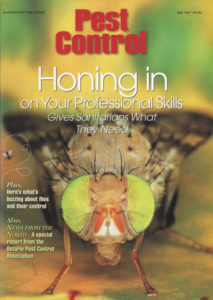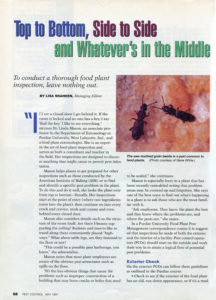
COVER: PMP ARCHIVES
If we need a slogan for best practices in stored product pest management, the title of an article in the May 1997 issue of Pest Control — the previous iteration of Pest Management Professional — should be a contender: “Top to bottom, side to side and whatever’s in the middle.”
The title sums up the recommendations of Purdue University entomologist Dr. Linda Mason for inspections of food plants, where stored product pests are among the most common infestations. Food plant inspections were a specialty of Dr. Mason, who today is dean of Purdue’s Graduate School. As the 1997 article notes:
Her inspections start at the point of entry (where raw ingredients come into the plant), then continue on into every crack and crevice, nook and cranny and even behind every closed door.
Then-Managing Editor Lisa Shaheen, who wrote the 1997 article, provides a comprehensive checklist, moving from the exterior to the interior of a structure, citing a Purdue University Food Plant Pest Management correspondence course. Here are a few good reminders from that list that still resonate today:
- Other buildings in the area, for example, abandoned grain elevators or storage sheds, may be creating pest problems for the food plant.
- The trash compactor must be kept clean. The compactor and all trash receptacles must be well-maintained, not allowing old food residues to accumulate and become caked onto the trash equipment.
- Inspect all storage facilities for proper storage practices and cleanliness.

PHOTO: PMP ARCHIVES
As pest management professionals (PMPs) who service food plant accounts would agree, Dr. Mason says the key to an effective inspection and management solution is close cooperation with and education of clients during and after inspection. If a plant owner prevents a PMP from accessing “every crack and crevice, nook and cranny,” for example, it’s much more difficult to find the source of infestation. Plus, employees are some of the best sources when sleuthing for harborage sites.
“Ask employees. They know the plant the best and they know where the problems are, and where the pests are,” Dr. Mason states in the article.
While employees may point in the right direction, it’s often up to the PMP to recognize less-obvious problems. On Dr. Mason’s list of top culprits are “improper construction of a building that may leave cracks or holes that need to be sealed” and recently remodeled buildings, where trouble spots may have been covered up.
Even when the solutions are straightforward — and they often are as simple as “fixing holes in screens, repositioning improperly placed [insect light traps, or ILTs] and sealing holes” — Dr. Mason reminds us that what’s common sense for PMPs is not always common sense for food plant personnel. It’s therefore critical to master the art of the follow-up:
As [Dr.] Mason points out, it’s not uncommon for food plant managers to have little knowledge of pest control or even sanitation, so after conducting an inspection, she sits down with the manager and reviews not only existing problems, but potential trouble spots as well.
The article details one case in which a client had purchased ILTs, but placed them directly in doorways. Instead of catching insects inside the plant, the traps were just drawing them in from the outside.
Dr. Mason’s follow-up strategy in the article was as thorough as her inspection process. She advises giving clients a carefully prioritized list addressing immediate concerns, and then ongoing measures to be completed over time.
Leave A Comment